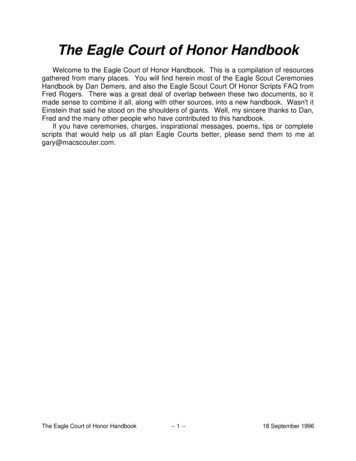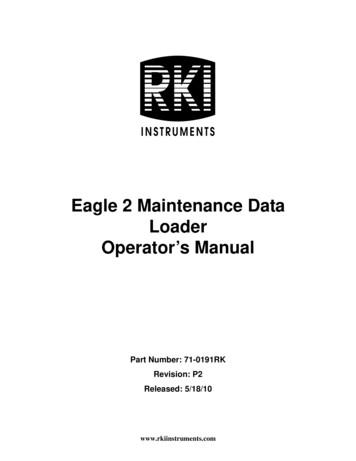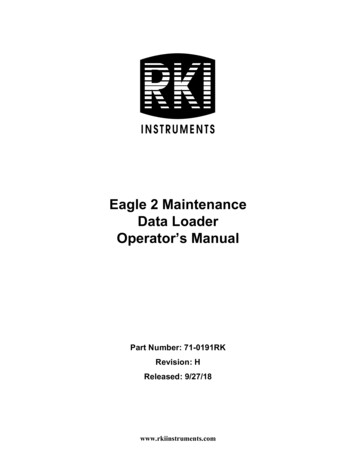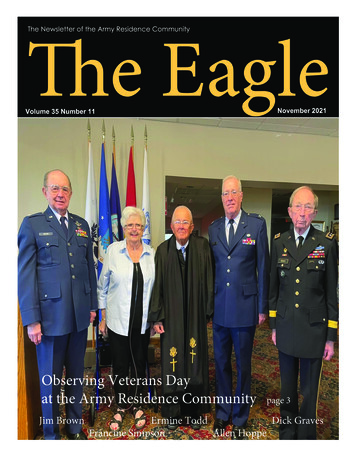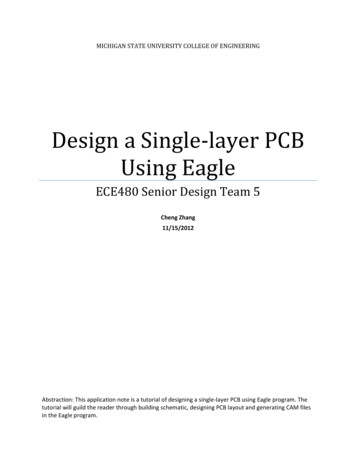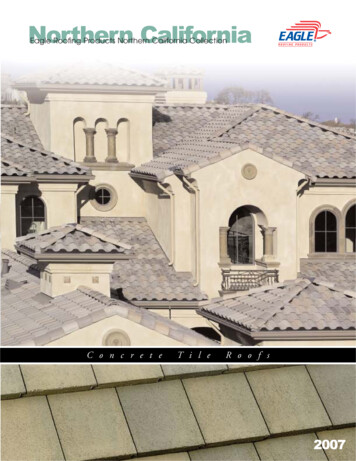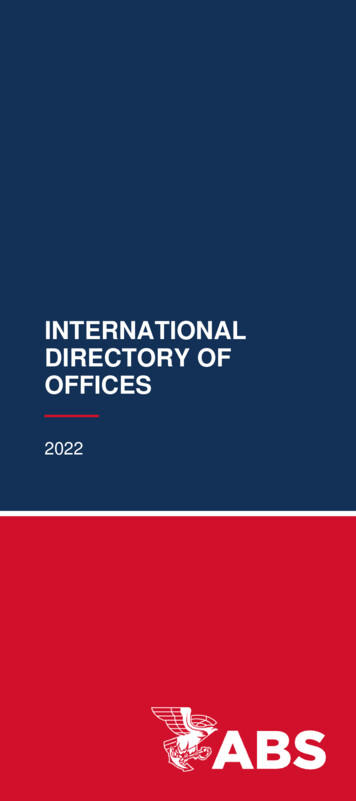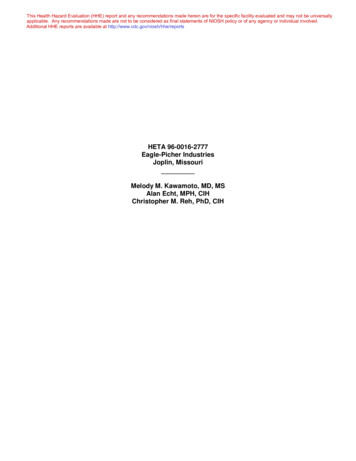
Transcription
ThisThis HealthHealth HazardHazard EvaluationEvaluation (HHE)(HHE) reportreport andand anyany recommendationsrecommendations mademade hereinherein areare forfor thethe specificspecific facilityfacility evaluatedevaluated andand maymay notnot bebe universallyuniversallyapplicable. /www.cdc.gov/niosh/hhe/reportsThis Health Hazard Evaluation (HHE) report and any recommendations made herein are for the specific facility evaluated and may not be universallyapplicable. Any recommendations made are not to be considered as final statements of NIOSH policy or of any agency or individual involved.Additional HHE reports are available at http://www.cdc.gov/niosh/hhe/reportsHETA 96-0016-2777Eagle-Picher IndustriesJoplin, MissouriMelody M. Kawamoto, MD, MSAlan Echt, MPH, CIHChristopher M. Reh, PhD, CIH
PREFACEThe Hazard Evaluations and Technical Assistance Branch of NIOSH conducts field investigations of possiblehealth hazards in the workplace. These investigations are conducted under the authority of Section 20(a)(6)of the Occupational Safety and Health Act of 1970, 29 U.S.C. 669(a)(6) which authorizes the Secretary ofHealth and Human Services, following a written request from any employer or authorized representative ofemployees, to determine whether any substance normally found in the place of employment has potentiallytoxic effects in such concentrations as used or found.The Hazard Evaluations and Technical Assistance Branch also provides, upon request, technical andconsultative assistance to Federal, State, and local agencies; labor; industry; and other groups or individualsto control occupational health hazards and to prevent related trauma and disease. Mention of company namesor products does not constitute endorsement by the National Institute for Occupational Safety and Health.ACKNOWLEDGMENTS AND AVAILABILITY OF REPORTThis report was prepared by Melody Kawamoto, Alan Echt, and Christopher Reh, of the Hazard Evaluationsand Technical Assistance Branch, Division of Surveillance, Hazard Evaluations and Field Studies(DSHEFS). Field assistance was provided by Eric J. Esswein and Barbara A. MacKenzie. Specimens forquality assurance of biological monitoring for lithium were provided by Peter M. Eller, Ph.D. Arrangementsfor analysis of biological specimens of lithium and mercury were made by Alexander W. Teass, Ph.D.Correlation analysis of the lithium data was performed by Charles A. Mueller, M.S. Desktop publishing wasperformed by Kathleen Mitchell and Patricia McGraw. Review and preparation for printing was performedby Penny Arthur.Copies of this report have been sent to employee and management representatives at Eagle-Picher and theOSHA Regional Office. This report is not copyrighted and may be freely reproduced. Single copies of thisreport will be available for a period of three years from the date of this report. To expedite your request,include a self-addressed mailing label along with your written request to:NIOSH Publications Office4676 Columbia ParkwayCincinnati, Ohio 45226800-356-4674After this time, copies may be purchased from the National Technical Information Service (NTIS) at5825 Port Royal Road, Springfield, Virginia 22161. Information regarding the NTIS stock number may beobtained from the NIOSH Publications Office at the Cincinnati address.For the purpose of informing affected employees, copies of this report shall beposted by the employer in a prominent place accessible to the employees for aperiod of 30 calendar days.ii
Highlights of the NIOSH Health Hazard EvaluationLithium and Mercury Exposures at Eagle-PicherNIOSH was asked by the union to assess worker exposure to several chemical hazards, includinglithium and mercury. Several site visits were made between December 1995 and April 1996.the negative pasting area than the mercurytreatment area, but most mercury levels werebelow recommended exposure limits.What NIOSH Did# Measured the air in the process room, pill# Urine mercury levels did not showroom, and dry room 108 for lithium.overexposure to mercury.# Measured lithium in employees’ blood in theWhat Managers Can Doprocess room, pill room, and dry room 108.# Measured lithium on employees’ hands in the# Install local exhaust ventilation to controlpill room and dry room.mercury exposure in the processors’ workstations.# Measured mercury in the air in the treatmentand negative pasting areas.# Provide and launder work clothes for# Measured mercury in employees’ urine in themercury-exposed employees.treatment and negative pasting areas.# Providea comprehensive medicalsurveillance program for mercury-exposedworkers.What NIOSH Found# Lithium levels in air and blood were highestWhat the Employees Can Doin the process room, similar but a little lowerin the pill room, and even lower in the dryroom.# Avoid eating, drinking, or smoking in workareas.# Lithium levels in blood were well belowlevels known to be toxic.# Wash hands and face on leaving the lithiumareas.# Lithium levels on employees’ hands werehigher in the pill room than in the dry room.# Shower and change into street clothes afterworking in mercury-exposed areas.# Mercury levels in air were a little higher inCDCCENTERS FOR DISEASE CONTROLAND PREVENTIONWhat To Do For More Information:We encourage you to read the full report. If youwould like a copy, either ask your health andsafety representative to make you a copy or call1-513/841-4252 and ask forHETA Report #96-0016iii
Health Hazard Evaluation Report 96-0016-2777Eagle-Picher IndustriesJoplin, MissouriMarch 1999Melody M. Kawamoto, MD, MSAlan Echt, MPH, CIHChristopher M. Reh, PhDSUMMARYOn October 20, 1995, the National Institute for Occupational Safety and Health (NIOSH) received a requestfor a health hazard evaluation (HHE) at Eagle-Picher Industries, Inc., in Joplin, Missouri. The request wassubmitted by a representative of the United Steelworkers of America Rubber/Plastic Industry Conference,in Akron, Ohio. The request concerned potential employee exposures to a number of chemical hazards,particularly lithium, mercury, and lead chromate, in various operations at the facility. Following awalkthrough survey at the plant on December 12-13, 1995, the NIOSH investigators focused on lithiumexposures in the process room, pill room, and dry room 108; mercury exposures in the pit and pasting room;identifying an orange substance on the walls in the potting area; and investigating the cause of eye irritationin the solder room. NIOSH investigators returned to the plant on April 17, 1996, and conducted anotherwalkthrough survey to plan for two full days of industrial hygiene and biological monitoring of employeeexposures to lithium and mercury, which took place on April 18-19, 1996.For lithium, NIOSH investigators conducted an exposure assessment for all day-shift employees working inthe process room, the pill room, and dry room 108. The exposure assessment was comprised of biologicalmonitoring, full-shift personal breathing zone air monitoring, and hand-wipe sampling. In addition, a selfadministered questionnaire was used to assess other factors that could affect serum lithium concentrations.Collection of serum specimens from 41 participants giving informed consent was conducted near the end ofthe day shift at the end of a work week, when serum lithium concentrations are expected to be at or nearsteady state. The geometric mean serum lithium concentration was 1.75 micrograms per liter (µg/l), witha range of “not detected” to 11.2 µg/l. These serum lithium concentrations were well below therapeutic andtoxic concentrations established for patients taking lithium medication. Serum lithium concentrations,however, differed by work area, showing that occupational exposure was occurring. Workers in the processroom (5.59 µg/l) and pill room (4.14 µg/l) had higher mean concentrations than workers in the dry room(1.09 µg/l).Over a 2-day period, NIOSH industrial hygienists collected full-shift personal breathing zone (PBZ) samplesfor lithium among 39 employees in the process room, the pill room, and dry room 108. The overall geometricmean concentration of lithium in air was 1.79 micrograms per cubic meter (µg/m3), with a range of “notdetected” to 121.8 µg/m3. As with the serum concentrations, the air sampling indicated higher meanexposures for process room ( 25.9 µg/m3) and pill room workers (15.3 µg/m3) compared with dry-roomworkers (0.45 µg/m3).On the second day of sampling, hand-wipe samples for lithium were collected from 10 employees in the pillroom and 14 employees in dry room 108. Samples were collected as employees left their work to go tolunch. The geometric mean of lithium on the wipe samples was 61.7 µg, with a range of 9 to 649 µg. Themean result among pill room workers (174.9 µg) was higher than those among dry-room workers (29.3 µg).iv
Additional environmental samples were collected to address other issues raised in the request. Analysis ofa bulk sample of dust collected from a diffuser in the potting area showed that the majority of the sample wascomposed of a variety of phthalate esters. Bis-phenol A and some of its derivatives, which are consistentwith the presence of epoxy resins, were also major components. The presence of the constituents of thepotting compounds on the diffuser may indicate that these substances are being recirculated in the workroomair.A wipe sample was collected from the exterior of a duct near the diffuser. The sample was analyzed formetals. Results showed the presence of aluminum, barium, cadmium, cobalt, chromium, copper, iron,lithium, magnesium, manganese, mercury, molybdenum, nickel, lead, phosphorous, silver, titanium,vanadium, yttrium, zinc, zirconium. Two short-term PBZ air samples were collected to assess employeeexposure to rosin solder flux decomposition products, specifically aldehydes and formaldehyde. The resultsindicated that none of these products were present in amounts greater than the limits of detection for themethod.Mercury (Hg) exposure monitoring and urine Hg concentrations were determined among workers in the Hgtreatment and negative pasting areas. The overall average Hg full-shift time weighted average (TWA)exposure concentration was 18.3 µg/m3, and the TWA exposure concentrations ranged from 3.5 to 48.3µg/m3. Only 2 of 17 full-shift TWA Hg exposure measurements exceeded the American Conference ofGovernmental and Industrial Hygienists (ACGIH) TLV for Hg of 25 µg/m3, and both of these were fromprocessors in the negative pasting area. In general, Hg exposures in the negative pasting area were slightlyhigher than those in the Hg treatment area. No Hg over-exposures were found during short-term, task-basedair sampling. Only 1 of 17 workers had a urine Hg concentration above the ACGIH Biological ExposureIndex, and the reasoning behind this high level could not be determined in this survey.Results of the NIOSH health hazard evaluation show that there is no health hazard from lithiumexposures at this Eagle Pitcher facility. In addition, though mercury exposures were generally low,there was some indication that processing jobs had the potential to pose a mercury hazard.Recommendations are made to continue to keep lithium exposures at low levels and to better protectmercury-exposed workers.KEYWORDS: SIC no.3692 (Primary Batteries, Dry and Wet), thermal battery manufacturing, lithium[CAS 7439-93-2], lithium alloy, lithium aluminum, lithium silicon, lithium salt, lithium chloride, lithiumfluoride, mercury [CAS 7439-97-6], rosin solder flux, colophony, biological monitoring, industrial hygienesampling, hand-wipe sampling, exhaust ventilationv
TABLE OF CONTENTSPreface . . . . . . . . . . . . . . . . . . . . . . . . . . . . . . . . . . . . . . . . . . . . . . . . . . . . . . . . . . . . . . . . . . . . . . . . . . . . iiAcknowledgments and Availability of Report . . . . . . . . . . . . . . . . . . . . . . . . . . . . . . . . . . . . . . . . . . . . . iiHHE Supplement . . . . . . . . . . . . . . . . . . . . . . . . . . . . . . . . . . . . . . . . . . . . . . . . . . . . . . . . . . . . . . . . . . . . iiiSummary . . . . . . . . . . . . . . . . . . . . . . . . . . . . . . . . . . . . . . . . . . . . . . . . . . . . . . . . . . . . . . . . . . . . . . . . . . ivIntroduction . . . . . . . . . . . . . . . . . . . . . . . . . . . . . . . . . . . . . . . . . . . . . . . . . . . . . . . . . . . . . . . . . . . . . . . . 1Background . . . . . . . . . . . . . . . . . . . . . . . . . . . . . . . . . . . . . . . . . . . . . . . . . . . . . . . . . . . . . . . . . . . . . . . .Thermal Battery Production . . . . . . . . . . . . . . . . . . . . . . . . . . . . . . . . . . . . . . . . . . . . . . . . . . . . . . . .Lithium Area . . . . . . . . . . . . . . . . . . . . . . . . . . . . . . . . . . . . . . . . . . . . . . . . . . . . . . . . . . . . . . . . .Potting Area . . . . . . . . . . . . . . . . . . . . . . . . . . . . . . . . . . . . . . . . . . . . . . . . . . . . . . . . . . . . . . . . .Soldering Area . . . . . . . . . . . . . . . . . . . . . . . . . . . . . . . . . . . . . . . . . . . . . . . . . . . . . . . . . . . . . . .Mercury Area . . . . . . . . . . . . . . . . . . . . . . . . . . . . . . . . . . . . . . . . . . . . . . . . . . . . . . . . . . . . . . . . . . .111222Methods . . . . . . . . . . . . . . . . . . . . . . . . . . . . . . . . . . . . . . . . . . . . . . . . . . . . . . . . . . . . . . . . . . . . . . . . . . .Thermal Battery Area . . . . . . . . . . . . . . . . . . . . . . . . . . . . . . . . . . . . . . . . . . . . . . . . . . . . . . . . . . . . .Lithium Area . . . . . . . . . . . . . . . . . . . . . . . . . . . . . . . . . . . . . . . . . . . . . . . . . . . . . . . . . . . . . . . . .Potting Area . . . . . . . . . . . . . . . . . . . . . . . . . . . . . . . . . . . . . . . . . . . . . . . . . . . . . . . . . . . . . . . . .Soldering Area . . . . . . . . . . . . . . . . . . . . . . . . . . . . . . . . . . . . . . . . . . . . . . . . . . . . . . . . . . . . . . .Mercury Area . . . . . . . . . . . . . . . . . . . . . . . . . . . . . . . . . . . . . . . . . . . . . . . . . . . . . . . . . . . . . . . . . . .333445Evaluation Criteria . . . . . . . . . . . . . . . . . . . . . . . . . . . . . . . . . . . . . . . . . . . . . . . . . . . . . . . . . . . . . . . . . . . 5Lithium . . . . . . . . . . . . . . . . . . . . . . . . . . . . . . . . . . . . . . . . . . . . . . . . . . . . . . . . . . . . . . . . . . . . . . . . 6Chemistry . . . . . . . . . . . . . . . . . . . . . . . . . . . . . . . . . . . . . . . . . . . . . . . . . . . . . . . . . . . . . . . . . . . 6Biokinetics . . . . . . . . . . . . . . . . . . . . . . . . . . . . . . . . . . . . . . . . . . . . . . . . . . . . . . . . . . . . . . . . . . 6General Population . . . . . . . . . . . . . . . . . . . . . . . . . . . . . . . . . . . . . . . . . . . . . . . . . . . . . . . . . . . . 6Exposed Workers . . . . . . . . . . . . . . . . . . . . . . . . . . . . . . . . . . . . . . . . . . . . . . . . . . . . . . . . . . . . . 6Medical Use . . . . . . . . . . . . . . . . . . . . . . . . . . . . . . . . . . . . . . . . . . . . . . . . . . . . . . . . . . . . . . . . . 7Side Effects and Toxicity . . . . . . . . . . . . . . . . . . . . . . . . . . . . . . . . . . . . . . . . . . . . . . . . . . . . . . . 7Evaluation Criteria . . . . . . . . . . . . . . . . . . . . . . . . . . . . . . . . . . . . . . . . . . . . . . . . . . . . . . . . . . . . 8Mercury . . . . . . . . . . . . . . . . . . . . . . . . . . . . . . . . . . . . . . . . . . . . . . . . . . . . . . . . . . . . . . . . . . . . . . . . 8Biokinetics . . . . . . . . . . . . . . . . . . . . . . . . . . . . . . . . . . . . . . . . . . . . . . . . . . . . . . . . . . . . . . . . . . 8Effects . . . . . . . . . . . . . . . . . . . . . . . . . . . . . . . . . . . . . . . . . . . . . . . . . . . . . . . . . . . . . . . . . . . . . . 9Evaluation Criteria . . . . . . . . . . . . . . . . . . . . . . . . . . . . . . . . . . . . . . . . . . . . . . . . . . . . . . . . . . . . 9Rosin (Colophony) . . . . . . . . . . . . . . . . . . . . . . . . . . . . . . . . . . . . . . . . . . . . . . . . . . . . . . . . . . . . . . . 9Exhaust Ventilation Recirculation . . . . . . . . . . . . . . . . . . . . . . . . . . . . . . . . . . . . . . . . . . . . . . . . . . 10Results . . . . . . . . . . . . . . . . . . . . . . . . . . . . . . . . . . . . . . . . . . . . . . . . . . . . . . . . . . . . . . . . . . . . . . . . . . .Thermal Battery Area . . . . . . . . . . . . . . . . . . . . . . . . . . . . . . . . . . . . . . . . . . . . . . . . . . . . . . . . . . . .Lithium Area . . . . . . . . . . . . . . . . . . . . . . . . . . . . . . . . . . . . . . . . . . . . . . . . . . . . . . . . . . . . . . . .Potting Area . . . . . . . . . . . . . . . . . . . . . . . . . . . . . . . . . . . . . . . . . . . . . . . . . . . . . . . . . . . . . . . .Soldering Area . . . . . . . . . . . . . . . . . . . . . . . . . . . . . . . . . . . . . . . . . . . . . . . . . . . . . . . . . . . . . .Mercury Area . . . . . . . . . . . . . . . . . . . . . . . . . . . . . . . . . . . . . . . . . . . . . . . . . . . . . . . . . . . . . . . . . .101010111111Discussion . . . . . . . . . . . . . . . . . . . . . . . . . . . . . . . . . . . . . . . . . . . . . . . . . . . . . . . . . . . . . . . . . . . . . . . . 12Thermal Battery Area . . . . . . . . . . . . . . . . . . . . . . . . . . . . . . . . . . . . . . . . . . . . . . . . . . . . . . . . . . . . 12Lithium Area . . . . . . . . . . . . . . . . . . . . . . . . . . . . . . . . . . . . . . . . . . . . . . . . . . . . . . . . . . . . . . . . 12vii
Potting Area . . . . . . . . . . . . . . . . . . . . . . . . . . . . . . . . . . . . . . . . . . . . . . . . . . . . . . . . . . . . . . . . 13Soldering Area . . . . . . . . . . . . . . . . . . . . . . . . . . . . . . . . . . . . . . . . . . . . . . . . . . . . . . . . . . . . . . 13Mercury Areas . . . . . . . . . . . . . . . . . . . . . . . . . . . . . . . . . . . . . . . . . . . . . . . . . . . . . . . . . . . . . . . . . . 13Recommendations . . . . . . . . . . . . . . . . . . . . . . . . . . . . . . . . . . . . . . . . . . . . . . . . . . . . . . . . . . . . . . . . . .Thermal Battery Area . . . . . . . . . . . . . . . . . . . . . . . . . . . . . . . . . . . . . . . . . . . . . . . . . . . . . . . . . . . .Lithium Area . . . . . . . . . . . . . . . . . . . . . . . . . . . . . . . . . . . . . . . . . . . . . . . . . . . . . . . . . . . . . . . .Potting Area . . . . . . . . . . . . . . . . . . . . . . . . . . . . . . . . . . . . . . . . . . . . . . . . . . . . . . . . . . . . . . . .Mercury Area . . . . . . . . . . . . . . . . . . . . . . . . . . . . . . . . . . . . . . . . . . . . . . . . . . . . . . . . . . . . . . . . . .1313131313References . . . . . . . . . . . . . . . . . . . . . . . . . . . . . . . . . . . . . . . . . . . . . . . . . . . . . . . . . . . . . . . . . . . . . . . . 15viii
INTRODUCTIONOn October 20, 1995, the National Institute forOccupational Safety and Health (NIOSH)received a request for a health hazard evaluation(HHE) at Eagle-Picher Industries, Inc., in Joplin,Missouri. The request was submitted by arepresentative of the United Steelworkers ofAmerica Rubber/Plastic Industry Conference, inAkron, Ohio. The request concerned potentialemployee exposures to a number of chemicalhazards, particularly lithium, mercury, and leadchromate, in various operations at the facility.Following a walkthrough survey at the plant onDecember 12-13, 1995, the NIOSH investigatorsfocused on lithium exposures in the process room,pill room, and dry room 108; mercury exposuresin the pit and pasting room; identifying an orangesubstance on the walls in the potting area; andinvestigating the cause of eye irritation in thesolder room.A lead chromate batterymanufacturing operation was to have beenincluded, but this process was shut downpermanently in February 1996.NIOSHinvestigators returned to the plant on April 17,1996, and conducted another walkthrough surveyto plan for two full days of industrial hygiene andbiological monitoring of employee exposures tolithium and mercury, which took place on April18-19, 1996. Individual results of the biologicalmonitoring were sent to participants in August(mercury) and October (lithium) 1996.BACKGROUNDThe Eagle-Picher Industries Couples Departmentplant in Joplin develops and produces highperformance special purpose battery systems,especially for military or aerospace applications.Products manufactured at the plant includethermal batteries, lithium-metal sulfide batteries,sodium-sulfur batteries, lead fluoroboric batteries,nickel-iron batteries, electroexplosive devices(e.g., squibs, wire cutters, matches, etc.), andmechanical actuators.Thermal Battery ProductionHealth Hazard Evaluation Report No. 96-0016Workers in thermal battery production wereprimarily concerned about their exposures tolithium powder. They were aware of the use andtoxicity of lithium medications and wonderedwhether cases of depression or diabetes amongsome of the workers and cases of attention-deficitdisorders among some of the workers’ childrencould be related to lithium. They also wanted toknow the significance of results of the airsampling conducted by the company in 1992,which showed concentrations of total lithium from0.07 to 0.475 milligrams per cubic meter (mg/m3)as time-weighted averages. Potentially exposedemployees were estimated to number 4 in theprocess room, 23 in the pill room, and 48 in dryroom 108.In thermal battery systems, lithium-basedelectrolyte is a solid at room temperature and hasa very low conductivity. The electrolyte becomesionically conductive when raised above itsmelting point. The cell is then capable ofdelivering energy for long periods of time.Pyrotechnic heat sources are the principal meansof heating thermal batteries. A percussion-typeprimer or electrical impulse to an integralelectrical match activates the battery.1 Theelectrolyte in batteries is in the form of pills,which vary in density, diameter, and composition.Lithium compounds used in battery pills includelithium aluminum, lithium silicon, lithiumchloride, lithium fluoride, and lithium oxide.Lithium AreaPowder for the pills is mixed in the process room.Operators open sealed cans containing mason jarsfilled with 600-gram aliquots of powderedmaterials. They empty the jars into a clean can ona scale under a hood then vacuum each emptymason jar to remove any remaining material. Alift raises the can of weighed material (a charge)to a V-blender, which blends the powder. Eachcharge contains 25,000 grams of powder. Afterblending, the operators dispense the powder intoclean mason jars, which are stored in the processarea until needed for pill production. The processoperators wear cotton coveralls and a half-maskrespirator. Operations in this area are performedover two shifts, with two employees per shift.Page 1
The pill room, located in building 108, houseseight large hydraulic presses (six 175-ton presses,one 350-ton press, and one 410-ton press) thatproduce battery pills. Due to the reactive natureof the materials used and strict quality controlrequirements, the relative humidity in the pillroom is maintained between 1% and 3%. Pressoperators fill feed hoppers located on the rear ofthe presses, typically every 30 to 45 minutes (thisfrequency varies with the type of pill beingproduced), monitor the operation of the presses,remove pills by raking them out of the press areaand placing them into containers, and weigh thepills. Operators are also responsible for cleaningthe presses. The group leader stacks and countsthe pills, places them in vacuum ovens overnight,and puts the dry pills in mason jars. Pressoperators wear latex gloves (Satari or Safeskinbrands), and cotton glove liners are available(these were used by one operator). The groupleader uses cloth gloves with leather palms.Gerson 1710 dust and mist respirators (TC-21C271) are available for use, but not required. Theoperators and group leader wear cotton coveralls.During the week of this study, 9 press operators,3 technicians, 1 group leader, and 1 qualitycontrol employee were working the day shift inthe pill room. Approximately the same number ofemployees work the evening shift.Batteries are assembled by hand in dry room 108.Utility battery builders stack and wrap batterycomponents. These are loaded in casings by abattery loader. Welders seal the casings. Someparts fabrication, such as Fiberfrax cutting, takesplace in dry room 108 as well. Use of gloves ismandatory in dry room 108. During the week ofthis study, 18 battery builders, 3 welders, 1technician, 1 group leader, and 5 quality controlemployees were working in dry room 108. Theroom is occupied only during the day shift.Potting AreaIn the potting area for thermal battery production,potting compounds are mixed in hoods and heatedbefore use to make them pourable. The mixedpotting compounds are poured over parts (batteryheaders) held in jigs on tables in the work area.Ovens are used to cure the potting compounds.The exhaust air, including the exhaust air from theovens, is cleaned in the air handler with a carbonPage 2filter and electrostatic precipitator, tempered, andrecirculated in the potting area, where eightemployees work. Potting compounds includemethyl cyanoacrylate in an adhesive, salicylicacid, diethyltoluenediamine, epoxy resins,diethanolamine, and bisphenol A diglycidyl ether.Soldering AreaThe soldering operation evaluated during thisinvestigation takes place in a clean room.Contacts are soldered on batteries using solderingirons, 70/30 tin lead solder, a rosin flux, and smallamounts of isopropanol. Air in the room isrecirculated after being cleaned with a carbonfilter and electrostatic precipitator and tempered.Ten employees work in this area.Mercury AreaMercury exposures can potentially occur in themercury treatment and negative pasting areas atEagle-Picher. The mercury treatment processconsists of dipping negative battery plates into amercuric chloride solution. After dipping, theplates are soaked and rinsed, and thesoaking/rinsing cycle is dependent on the type ofbattery being built. Finally, the plates are dried inan oven. The oven operator wears an airpurifying respirator with mercury canisters.Negative pasting is the manufacture of negativebattery plates from a zinc/mercuric oxide blend.The zinc and mercuric oxides are weighed intostandard volumes depending on battery type, andwater and latex are added to the blend produce aslurry. The slurry is poured on perforated paper,and a vacuum is pulled through the paper toremove excess water and form the paste. Thepasted paper is attached to a grid assembly andwet pressed. Finally, the pressed plates are driedin an oven, and given a final dry press.METHODSThermal Battery AreaHealth Hazard Evaluation Report No. 96-0016
Lithium AreaBiological monitoring for serum lithium wasconducted on employees in thermal batteryproduction to determine their absorption oflithium in the workplace. Sampling of full-shiftpersonal breathing zone (PBZ) exposures tolithium was conducted to assess the potentialcontribution of inhalation exposure. Hand-wipemonitoring for lithium was conducted to assessthe potential contribution of ingestion via hand-tomouth exposure.A self-administeredquestionnaire was used to assess other factors thatcould affect serum lithium concentrations. Allday-shift employees working in the process room,the pill room, and dry room 108 were eligible toparticipate.Collection of serum specimens from participantsgiving informed consent was conducted near theend of the day shift on April 18-19, 1996(Thursday and Friday, at the end of a work week,when serum lithium concentrations are expectedto be at or near steady state). For quality control,duplicate specimens were collected on 10% ofemployees participating on each day. In addition,on each day, a specimen from an individual withlow exposure potential was split into three parts.Two of the three split specimens were spiked withlithium at one and two times the limit ofquantitation, while the remaining split specimenwas not spiked with lithium. Serum lithium wasmeasured by inductively coupled plasma-massspectroscopy (ICP-MS), which is capable ofmeasuring lithium in micromole per liter(µmole/L) concentrations.The limit ofquantitation (LOQ) for this method is 0.07µmole/L (which is equivalent to 0.5 µg/L). Lesssensitive methods are used to analyze clinicalspecimens to determine whether patients’ lithiumconcentrations are above the minimum therapeuticlimit and below the toxic limit, both of which areon the order of milligrams per liter (mg/L).Because lithium concentrations among nonpatient populations have been in micrograms perliter (which is on the order of a thousand timeslower than the milligram-per-liter concentrationsfound among patients taking lithium medicines),the more sensitive method was used to quantifythe serum lithium concentrations of Eagle-Pitcheremployees.Health Hazard Evaluation Report No. 96-0016All biological monitoring participants were askedto complete a self-administered questionnaire atthe time of the specimen collection to evaluatefactors that could not be measured byenvironmental sampling but could affect serumlithium concentrations.The questionnairecovered factors that could have affected exposurepotential during the previous week, such aschanges in work schedule or task assignment, useof gloves and coveralls, handwashing afterexposure (specifi
Eagle-Picher Industries Joplin, Missouri March 1999 Melody M. Kawamoto, MD, MS Alan Echt, MPH, CIH Christopher M. Reh, PhD SUMMARY On October 20, 1995, the National Institute for Occupational Safety and Health (NIOSH) received a request for a health hazard evaluation (HHE) at Eagle-Picher Industries, Inc., in Joplin, Missouri. The request was
